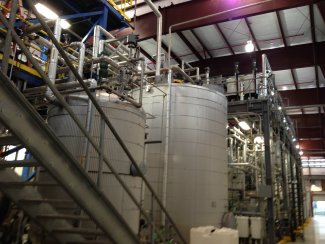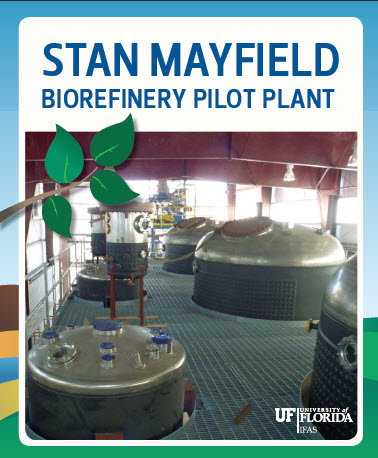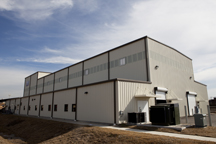Conversion
The overall goal of this work program is to improve lignocellulosic biomass processing technologies for fermentable sugar production and subsequently their conversion to biofuel. An additional emphasis of this program is on the processing and utilization of waste streams for recovery of nutrients, bioproduct production and for reuse of wastewater. This approach goes a long way in ensuring that the biofuel is manufactured with minimal environmental impact and there are additional revenues from biorefining. Currently biodiesel and ethanol are the commonly used liquid biofuels for transportation. Ethanol is used after blending with gasoline. Butanol is touted as an alternate to ethanol as it can directly substitute for gasoline in engines. Butanol can also be made from biomass using the direct biochemical (or fermentation) approach or via the butyric acid pathway which involves both biochemical and catalytic method steps.
 Revenues from biorefining can also be enhanced by making co-products along with the biofuel. Corn ethanol plants, for example may produce corn oil and an animal feed stream called distillers dry grains with solubles (DDGS) to add value to the process. Unlike DDGS, the predominantly lignin fiber remaining in the stillage after distillation in a cellulosic ethanol process has poor nutritive quality. So other uses for the stillage have to be developed. A readily implementable option is to anaerobically digest the stillage to produce biogas. The biogas can be used as a fuel in the plant. Anaerobic digestion will also serve as a treatment process for stillage. With further treatment the water may be reusable. Appropriate wastewater treatment processes that recover plant nutrients (like nitrogen and phosphorus) can also be considered. These nutrients can be used for growing the biomass. Water reuse and nutrient recycling can greatly minimize the environmental impact of the biofuel production process.
Revenues from biorefining can also be enhanced by making co-products along with the biofuel. Corn ethanol plants, for example may produce corn oil and an animal feed stream called distillers dry grains with solubles (DDGS) to add value to the process. Unlike DDGS, the predominantly lignin fiber remaining in the stillage after distillation in a cellulosic ethanol process has poor nutritive quality. So other uses for the stillage have to be developed. A readily implementable option is to anaerobically digest the stillage to produce biogas. The biogas can be used as a fuel in the plant. Anaerobic digestion will also serve as a treatment process for stillage. With further treatment the water may be reusable. Appropriate wastewater treatment processes that recover plant nutrients (like nitrogen and phosphorus) can also be considered. These nutrients can be used for growing the biomass. Water reuse and nutrient recycling can greatly minimize the environmental impact of the biofuel production process.
Conversion: Goals
- Improve lignocellulosic biomass processing technologies for fermentable sugar production and subsequently their conversion to biofuel
- Develop processing and utilization of waste streams for recovery of nutrients, bioproduct production and for reuse of wastewater
- Develop methods to ensure that the biofuel is manufactured with minimal environmental impact and there are additional revenues from biorefining
Conversion: Research Outcomes
- Metabolic engineering of E. coli for production of butyric acid.
An engineered E. coli strain producing butyrate at 28 g/L was developed. This titer is higher than that of other engineered E. coli strains reported in the literature. Our highest butyrate titer was 33 g/L, about 3-times the value of published values for recombinant butyrate producers. - Bench-scale fermentation of switchgrass to ethanol
An optimum pre-treatment condition and enzyme loading for an overall process for conversion of switchgrass to ethanol was identified. The ethanol yield of about 60 gallons per ton of switchgrass is comparable to the literature values for sugar cane bagasse and sweet sorghum bagasse. - Patents
Conversion: Research Publications
-
2018
-
- Awasthi, D., Wang, L., Rhee, M.S., Wang, Q., Chauliac, D., Ingram, L.O. and Shanmugam, K.T. (2018). Metabolic engineering of Bacillus subtilis for production of D-lactic acid. Biotechnology and Bioengineering 115(2):453-463. DOI: 10.1002/bit.26472
- Van Rijn, R., Nieves, I.U., Shanmugam, K.T., Ingram, L.O. and Vermerris, W. (2018). Techno-economic evaluation of cellulosic ethanol production based on pilot biorefinery data: a case study of sweet sorghum bagasse processed via L+SScF. BioEnergy Research. 11(2):414-425. DOI: 10.1007/s12155-018-9906-3
- Wu, W., Rondon, V., Weeks, K., Pullammanappallil, P., Ingram, L.O., and Shanmugam, K.T. (2018). Phosphoric acid based pretreatment of switchgrass and fermentation of entire slurry to ethanol using a simplified process. Bioresource Technology 251:171-180.
DOI: 10.1016/j.biortech.2017.12.041
-
-
2017
-
- Jamis, S. (2017). Land Applied Residual Effects on Soil Biogeochemical Properties. July 2017. A research report submitted as part of the MS degree requirement at the University of Florida.
- Riley, M.K. and Vermerris, W. (2017) Recent advances in nanomaterials for gene delivery—A review. Nanomaterials 7(5):94. DOI: 10.3390/nano7050094
-
-
2016
- Gubicza, K., Nieves, I.U., Sagues, W.J., Barta, Z., Shanmugam, K.T. and Ingram, L.O. (2016). Techno-economic analysis of ethanol production from sugarcane bagasse using a Liquefaction plus Simultaneous Saccharification and co-Fermentation process. Bioresource Technology 208:42-48. DOI: 10.1016/j.biortech.2016.01.093
- Jairam S., Bucklin, R., Correll, M., Sakthivel, T.S., Seal, S., Truett, J. and Tong, Z. (2016). UV resistance of polystyrene co-butyl acrylate (PSBA) encapsulated lignin-saponite nanohybrid composite film. Materials and Design 90:151-156.
DOI: 10.1016/j.matdes.2015.10.118 - Ou, M.S., Awasthi, D., Nieves, I., Wang, L., Erickson, J., Vermerris, W., Ingram, L.O. and Shanmugam, K.T. (2016). Sweet sorghum juice and bagasse as feedstocks for the production of optically pure lactic acid by native and engineered Bacillus coagulans strains. BioEnergy Research 9(1):123-131. DOI: 10.1007/s12155-015-9670-6
- Scully, E.D., Gries, T., Funnell-Harris, D.L., Xin, Z., Kovacs, F.A., Vermerris, W. and Sattler, S.E. (2016). Characterization of novel Brown midrib 6 mutations affecting lignin biosynthesis in sorghum. Journal of Integrative Plant Biology 58(2):136-149.
DOI: 10.1111/jipb.12375 - Shi, A., Zheng, H., Yomano, L.P., York, S.W., Shanmugam, K.T. and Ingram, L.O. (2016). Plasmidic expression of nemA and yafC* increased resistance of ethanologenic Escherichia coli LY180 to nonvolatile side products from dilute acid treatment of sugarcane bagasse and artificial hydrolysate. Applied and Environmental Microbiology 82(7):2137-2145.
DOI: 10.1128/AEM.03488-15n - Wang, J. and Vermerris, W. (2016). Antimicrobial nanomaterials derived from natural products - A review. Materials 9(4):255. DOI: 10.3390/ma9040255
-
2015
- Chauliac, D., Pullammanappallil, P.C., Ingram, L.O. and Shanmugam, K.T. (2015). Removing chiral contamination of lactate solutions by selective metabolism of the D-enantiomer. Biotechnology Letters 37(12):2411-2418. DOI: 10.1007/s10529-015-1924-z
- Geddes, R., Shanmugam, K.T. and Ingram, L.O. (2015). Combining treatments to improve the fermentation of sugarcane bagasse hydrolysates by ethanologenic Escherichia coli LY180. Bioresource Technology 189:15-22. DOI: 10.1016/j.biortech.2015.03.141
- Mondala, A., Hernandez, R., French, T., Green, M., McFarland, L. and Ingram, L. (2015). Enhanced microbial oil production by activated sludge microorganisms from sugarcane bagasse hydrolysate. Renewable Energy 78:114-118. DOI: 10.1016/j.renene.2014.12.073
- Sawisit, A., Jantama, K., Zheng, H., Yomano, L.P., York, S.W., Shanmugam, K.T. and Ingram, L.O. (2015). Mutation in galP improved fermentation of mixed sugars to succinate using engineered Escherichia coli AS 1600a and AM1 mineral salts medium. Bioresource Technology 193:433-441. DOI: 10.1016/j.biortech.2015.06.108
- Wang, L., Ou, M.S., Nieves, I., Erickson, J.E., Vermerris, W., Ingram, L.O. and Shanmugam, K.T. (2015). Fermentation of sweet sorghum derived sugars to butyric acid at high titer and productivity by a moderate thermophile Clostridium thermobutyricum at 50oC. Bioresource Technology 198:533-539. DOI: 10.1016/j.biortech.2015.09.062
- Zeng, J., Yoo, C.G., Wang, F., Pan, X., Vermerris, W. and Tong, Z. (2015). Biomimetic Fenton-catalyzed lignin depolymerization to high-value aromatics and dicarboxylic acids. ChemSusChem 8(5):861–871. DOI:10.1002/cssc.201403128
-
2014
- Castro, E., Nieves, I.U., Mullinnix, M.T., Sagues, W.J., Hoffman, R.W., Fernández-Sandoval, M.T., Tian, Z., Rockwood, D.L., Tamang, B. and Ingram, L.O. (2014). Optimization of dilute-phosphoric-acid steam pretreatment of Eucalyptus benthamii for biofuel production. Applied Energy 125:76-83. DOI: 10.1016/j.apenergy.2014.03.047
- Geddes, R.D., Wang, X, Yomano, L.P., Miller, E.N., Zheng, H., Shanmugam, K.T. and Ingram, L.O. (2014). Polyamine transporters and polyamines increase furfural tolerance during xylose fermentation with ethanologenic Escherichia coli strain LY180. Applied and Environmental Microbiology 80(19):5955-5964. DOI: 10.1128/AEM.01913-14
- Zeng, J., Tong, Z., Wang, L., Zhu, J.Y. and Ingram, L. (2014). Isolation and structural characterization of sugarcane bagasse lignin after dilute phosphoric acid plus steam explosion pretreatment and its effect on cellulose hydrolysis. Bioresource Technology 154:274-281. DOI: 10.1016/j.biortech.2013.12.072
-
2013
- Agyin-Birikorang, S., G.A. O’Connor and J.E. Erickson (2013). Sustainable nutrient management package for cost-effective bioenergy biomass production. Journal of Plant Nutrition 36(12):1881-1900. DOI: 10.1080/01904167.2013.818154
- Agyin-Birikorang, S., G.A. O’Connor, P.C. Pullammanappallil and G.R. Mohan (2013). Recovery of essential plant nutrients from biofuel residual. Journal of Sustainable Bioenergy Systems 3(2):149-159. DOI: 10.4236/jsbs.2013.32021
More Information?
-
Florida Center for Renewable Chemicals and Fuels (FCRC)
-

FCRC promotes a new concept in Florida with broad implications at the national and international levels - the creation of biorefineries that use renewable products from agriculture as feedstocks to replace petroleum-based products. (More...)
- Florida Center for Renewable Chemicals and Fuels Website
- UF Researchers Improve Process to Create Renewable Chemicals From Plants
-
-
Biocatalyst development for production of advanced biofuels
-
Biocatalyst development for production of advanced biofuels
(L. O. Ingram and K. T. Shanmugam, University of Florida)Objective: to develop microbial biocatalysts for conversion of lignocellulose derived sugars to advanced biofuels and organic acids, and integrate these biocatalysts with optimum biomass process conditions developed at our pilot plant, the Stan Mayfield Biorefinery. Due to the toxicity of our target advanced biofuel (butanol) to the fermenting microorganism, our objective is to develop microbial biocatalysts for production of butyric acid as the primary fermentation product at high titer and productivity. The butyric acid can be readily reduced to butanol using catalysts and the H2 produced during fermentation of sugars to butyric acid.
Studies on advanced biofuels will be focused on the two critical physiological characteristics of the biocatalyst that influence productivity: tolerance to inhibitors present in acid hydrolysate of various biomass feedstocks, and rapid utilization of hemicellulose-derived sugars in the presence of glucose.
In the production of organic acids, biocatalysts will be optimized for high titer and yield using various biomass feedstocks at the pilot plant level.
Deliverables:
- Advanced biofuels - A biocatalyst that ferments both glucose and xylose, dominant sugars in biomass, simultaneously at high rate and titer even in the presence of metabolic inhibitors generated during pre-treatment of biomass to butyric acid for further reduction to butanol.
- Organic Acids - A microbial biocatalyst that can grow in mineral salts medium for production of butyric acid at high titer and yield using acid-hydrolyzed bagasse and fibers from select biomass crops as feedstocks.
-
Conversion

Stan Mayfield Biorefinery Pilot Plant in Perry, FL